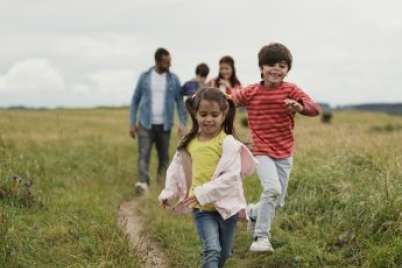
4 things nature teaches us about physical literacy
At Active for Life, we stress the importance of children developing physical literacy skills from an early age, and we even provide parents with a Skills Builder tool to help with this.
But did you know that in the animal kingdom parents instinctively develop physical literacy skills in their offspring shortly after they’re born (sometimes literally minutes after)?
Every day animals must contend with gravity, gradient, and fixed and moving objects. Walking, running, propelling through water, accelerating and decelerating, turning, jumping, climbing, and swinging are common activities for most species on our planet.
Here are four things nature teaches us about physical literacy:
1. Fundamental movement skills must be learned
While it’s true that most animals are born with a genetic blueprint that governs what they’re supposed to do (e.g. a lion is hardwired to hunt zebra, and a zebra is hardwired to avoid lions), in most cases the fundamental movement skills necessary to realizing their potential has to be learned.
Parental guidance is the key to unlocking that potential.
Take eagles, for example. Baby eagles are guided into flight by closely observing their parents. It’s not instinctive.
After about 8 to 10 weeks, once the baby’s flight feathers have begun to grow, the eagle parents will hover over the nest, flapping their wings and encouraging the babies to do the same.
Soon the babies mimic the action, slowly at first, and then gradually catching air under their flight feathers and rising above the nest.
Eventually, after days of practice, the fledglings become more and more confident with the mechanics of that action. Only then do the parents nudge them from the nest so that the young raptors can attempt their first flight.
2. Movement skills are essential to negotiating and interacting with one’s environment
Basic locomotion skills must be quickly learned by most animals. Walking, running, jumping and climbing are among the most common.
A hedgehog walks slowly and methodically to better observe its surroundings and search for food.
Predators like lions must run fast to cover long distances and catch fast fleeing prey.
Tree Frogs can jump 150 times their own body length, both to avoid capture, and negotiate their surroundings.
3. Early physical literacy development is key to long-term survival
For the vast majority of animals, advanced movement skills are essential to staying alive. And often there’s little time to waste in developing them.
If you’ve ever seen a newborn zebra, you’ll notice its mother prodding and encouraging the foal to stand moments after it’s born. Standing is the critical first step towards learning how to walk, to run … or to hide.
Remarkably, once upright, the young foal ― with continued encouragement from its mother ― can typically walk within 20 minutes, and run after about an hour! A potentially life-saving skill if there are physically literate lions around.
4. Play is crucial to developing physical literacy, socialization, and brain development
Having spent time working with young lions in Africa, I know from firsthand experience how important play is to the development of these big cats.
For a newborn lion cub, early play teaches the animal how to control, synchronize, and develop her muscles. Such playing develops eye and paw coordination, which, in turn, will enable her to master the many challenges she’ll encounter in her environment.
A few months later, when she playfully pins her indignant younger brother in a headlock, she is also learning the skills she will need to immobilize prey.
Elsewhere on the savannah, an impala fawn capering in a nursery group is actually practicing her escape routine to avoid ever becoming prey in the first place.
Play also reduces stress and improves socialization.
Certainly, lions and impalas are highly social creatures. But studies with rats have shown that when two or more of the young rodents are placed together, they start frolicking with abandon. But if you impede a young rat’s enthusiasm for play by rearing it alone, the result is an adult that quickly becomes antisocial.
The other thing the humble rat has revealed is that when they’re reared with companions ― along with interesting objects in their environment ― they develop larger brains than rats that grow up in spartan surroundings.
Perhaps not surprisingly, evidence suggests that primates (including humans) react in the same way.
Play isn’t just fun. It’s fundamental.
The next time you’re watching a documentary with your kids that features young animals in the natural world, see if you can spot how many different physical literacy skills the animals are using, and how those skills help them to interact with each other, and with their environment.





